A trader turns off his truck’s engine at yet another checkpoint and, again, the soldiers ask him for cash. His truck is filled with charcoal from Myanmar, destined for factories in China’s mountainous southwest province of Yunnan.
The charcoal will be fed into furnaces to produce silicon metal, a material so versatile it is used to manufacture everything from metal alloys to silicon chips and solar panels. Despite the cross-border charcoal trade being illegal, the practice contributes greatly to the livelihoods of modest farmers and traders in Myanmar’s riverside villages.
But every year, about 14,000 soccer fields of forests go up in flames to feed the smelters, while corrupt officials, especially in the military, collect bribes worth $1.2 million a year, and possibly over $10 million.
A nearly year-long investigation by Mongabay documents, for the first time, the routes used in this trade as well as its benefits and pitfalls.
Myanmar’s Village-Made Charcoal
In a thick forest near the regionally significant Irrawaddy River, a little upstream from the town of Katha, a cigarette in his hand, Myo Htun, a youthful-looking 38-year-old man, crouches next to a charcoal oven. It’s a big pile of burning wood covered with mud and it has just been cut open. Htun’s wife is raking the black blocks of wood away from the smouldering mound while his brother cools them down with water. A thick, wet smoke rises from the embers, engulfing the workers.
A truck is standing nearby. It’s hard to tell if it broke down a decade ago, or if it’s just parked. It’s Htun’s truck, and he uses it to carry other people’s charcoal from the forest to his village; but during the rainy season his neighbors are busy with other activities. Htun explains that “it’s difficult to make charcoal in the rainy season … when it rains, the water dissolves and washes away the soil we piled up [to make the oven].” He says it’s the first time he has made charcoal and he won’t be caught doing it during the rainy season again.
Htun and his family use the stumps of rosewood trees, left over from the valuable timber first chopped down by Htun’s forefathers. Nearly all the valuable trees in the forests around the town of Katha have been felled and exported, first by the British colonialists and then by the Myanmar government. With the stumps, Htun makes little squares of flooring, then he recycles the leftovers as charcoal. However, most producers in the area use standing trees such as Ceylon oak.
When they’re done, Htun’s brother and their wives will sell their production to a trader in their village. For the hefty work, he reckons he’ll get around $150, split equally between the two families.
Htun hopes to earn enough to pay for his three children’s schooling. His eldest daughter has failed her final year of high school, so he’ll have to spend about $1,000 on her board and education. When she graduates, she wants to open a beauty salon, then Htun will have to find more money, so he’ll take up odd jobs as a mechanic, a driver, and perhaps make charcoal again.
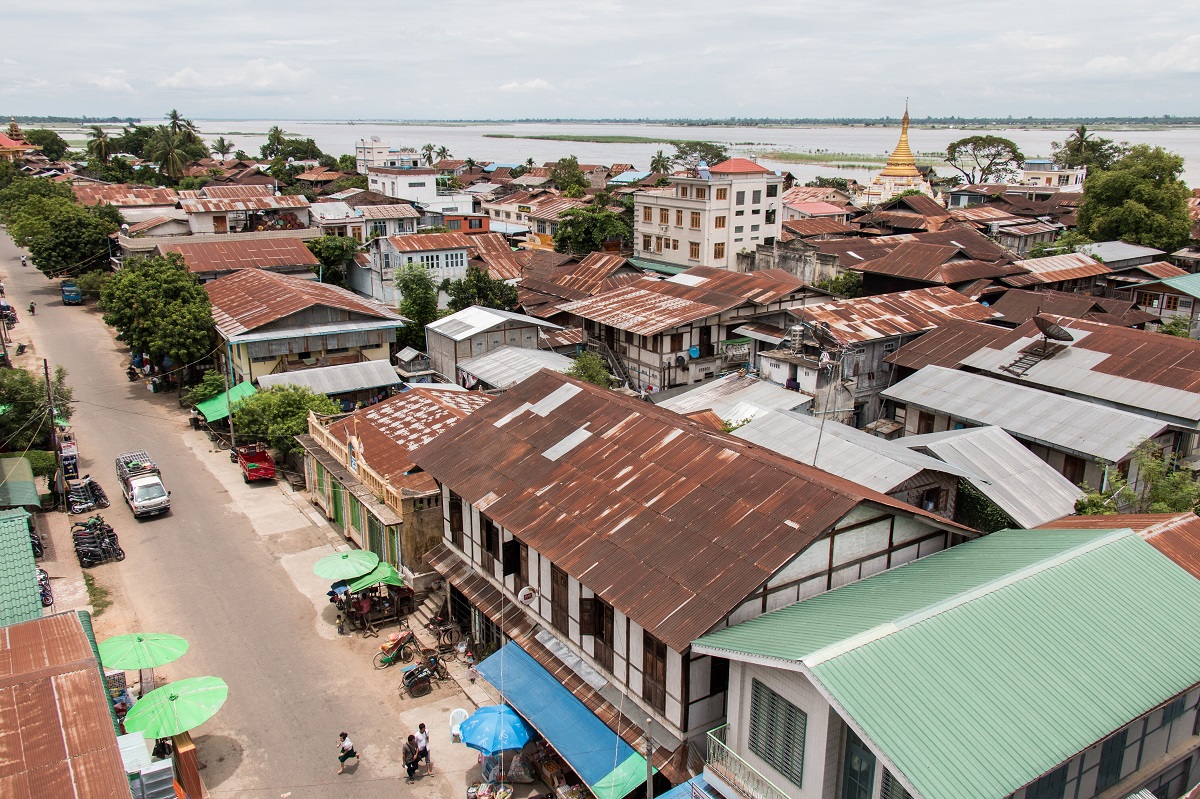
(Photo: Nathan Siegel/Mongabay)
Like in other riverside villages near Katha and a long way upstream, nearly everyone in Htun’s village produces charcoal along with their other livelihoods such as growing rice. It’s illegal to export charcoal made from wood, and most farmers don’t have the required permits to produce it in the first place; but “if the police arrested all those who make charcoal, then the prison would not have enough space,” as another producer told Mongabay.
A Grandma’s Place in Trade
One of the most important charcoal traders in Htun’s village is a sharp-witted, wrinkly grandmother who asked to remain anonymous. Her shop bordering the river sells biscuits and other small goods.
Much of the day, she sits in the back, drinking tea with a friend—either trading the wisdoms of old age, or just gossiping about the village. In the courtyard behind her shop stands a tall wall of pale green bags filled with lumpy charcoal.
She pours a cup of tea from a thermos waiting for unexpected guests, and says she’s been trading charcoal for the past 10 years.

(Photo: Nathan Siegel/Mongabay)
“We used to sell only a small quantity, like a boat full of charcoal,” she said. Then, from 2012 to 2014, “there was a huge illegal timber trade … now the government is taking action and people switched to this charcoal business.” At that time, around 2014, the demand for charcoal from China picked up, she says, confirming what other traders also said. Then, “the whole village joined the charcoal business.”
“People here are poor and all they do is charcoal and farming,” she said. “When people here cannot do charcoal business, they have no money to spend.”
Yet she has surprisingly mixed feelings about the trade.
“We know that it causes deforestation,” she said. She added they also know problems will arise once all the trees are cut down. “It will become hotter. There will be climate change.”
It’s not all bad, though.
“After cutting down trees for charcoal production, some people plant trees using seeds provided by the government,” she said. “They grow teak on that land to make the environment green.”
A couple of days later, a line of a dozen young women wearing a round patch of sandalwood make-up on their cheeks appear next to the tea shop. One by one, they head to the wall of charcoal bags and carry one on their shoulder. Under the watchful eye of the chubby captain, they slowly fill a barge moored nearby, skillfully balancing on the rickety planks laid between the shore and the boat.
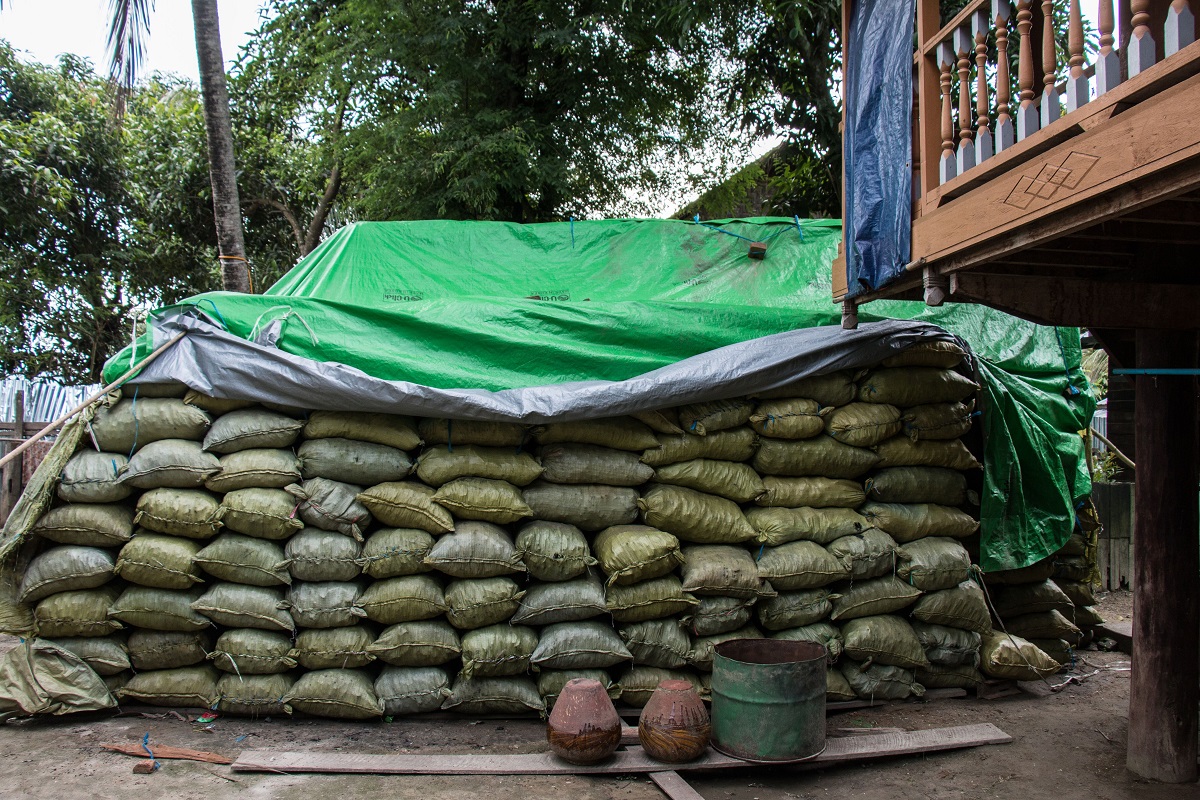
(Photo: Nathan Siegel/Mongabay)
The boat is headed to the town of Bhamo upstream in Kachin State; this is where the trader’s daughter lives, and she will arrange to sell the charcoal in China.
An Upriver Path
Although it’s quite large, the boat is rudimentary. Its deep wooden hull is topped by a tarpaulin roof. At the back, just above the engines, an open platform serves as the boat’s bridge and sleeping quarters.
The captain says he’ll have to pay around $300 to $350 in bribes to the officials manning checkpoints along the river, but he’s more worried about getting stuck on sandbanks. For each ton of charcoal that floats up the Irrawaddy, an estimated $10 to $25 is pocketed by corrupt officials, particular those in Myanmar’s Forest Department, according to research conducted for this investigation.
Finally, the boat’s engines come to life, coughing a thick cloud of black smoke, and the journey to Bhamo begins. It takes a long day of fighting the current and whirlpools of the Irrawaddy River, meandering through a landscape of alternating rice paddies and steep, forested hills.
Myanmar’s history has also floated along this river. In 1885, the English, who had already colonized Burma’s coast, set their eyes on the precious teak of the hinterland. They sent boats up the Irrawaddy to the king’s palace in Mandalay and snatched control of the country within a couple of weeks. The king and his court were sent downstream and then into exile in India.
In the following decades, the Irrawaddy would prove its worth to the British Empire. Teak’s strength and water resistance provided railway sleepers and ships’ hulls, bringing considerable income to the British. The teak logs that were felled in remote forests could be exported at unprecedented speed by floating them down from forest camps, to sawmills and then abroad. After Burma’s independence in 1948, teak remained one of the country’s main sources of income and the Irrawaddy one of the main routes for its trade.
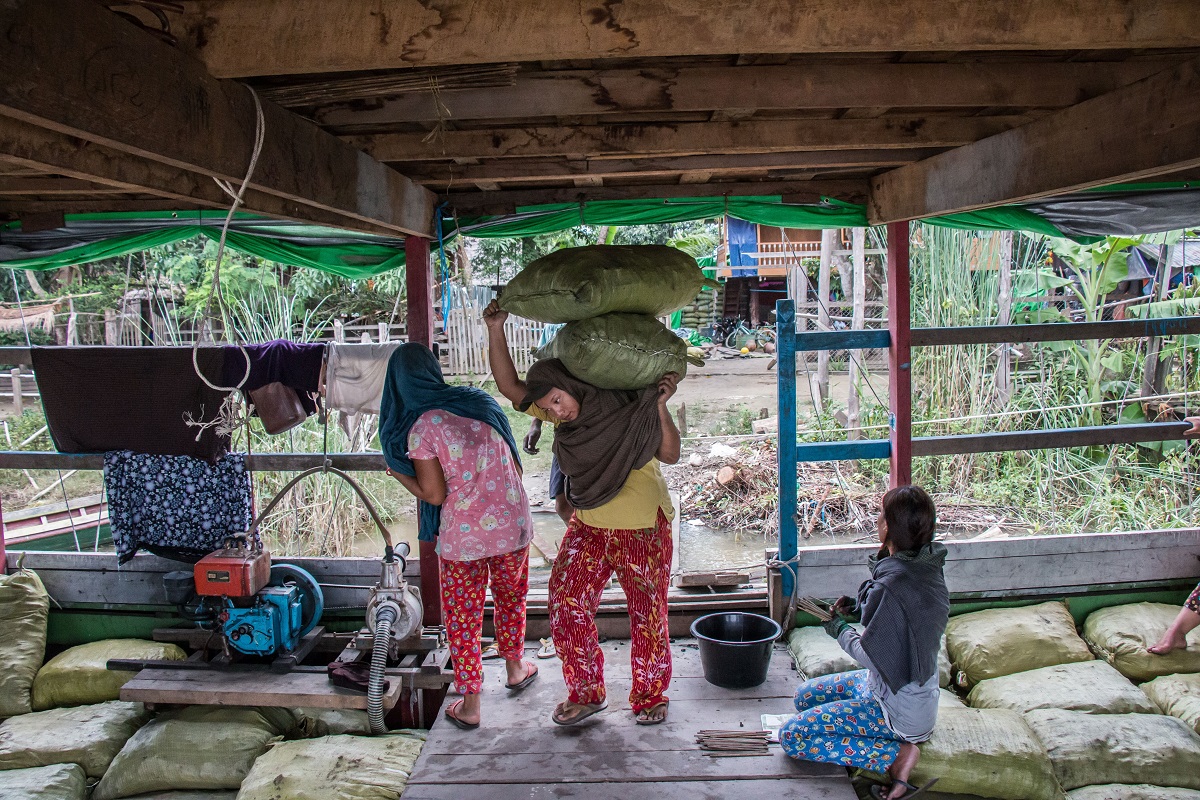
(Photo: Nathan Siegel/Mongabay)
Now, charcoal takes the reverse route, up the Irrawaddy, to join the stream of natural resources flowing from Myanmar to China, which in turn nourishes the global demand for consumer goods.
Crossing the Border by River and Road
According to the couple dozen people Mongabay interviewed, the charcoal exported to China transits via Bhamo—a riverside town where the Irrawaddy bends to lick the Chinese border. In a few makeshift ports, the boats spill their merchandise—charcoal, rice, maize – onto trucks destined for China. Bhamo is a quiet town, but the state of Kachin where it is located is home to a long-running conflict between the Myanmar government and a Kachin Army seeking independence for the region’s distinct ethnic group.
The road from Bhamo to China is busy, and exporting charcoal is not so simple. U Kyaw Zaw, director of the Natural Forests and Plantations Division in the Forest Department of the Ministry of Natural Resources and Environmental Conservation, told Mongabay in an interview that “the use of firewood and charcoal is one of the major causes of deforestation.”
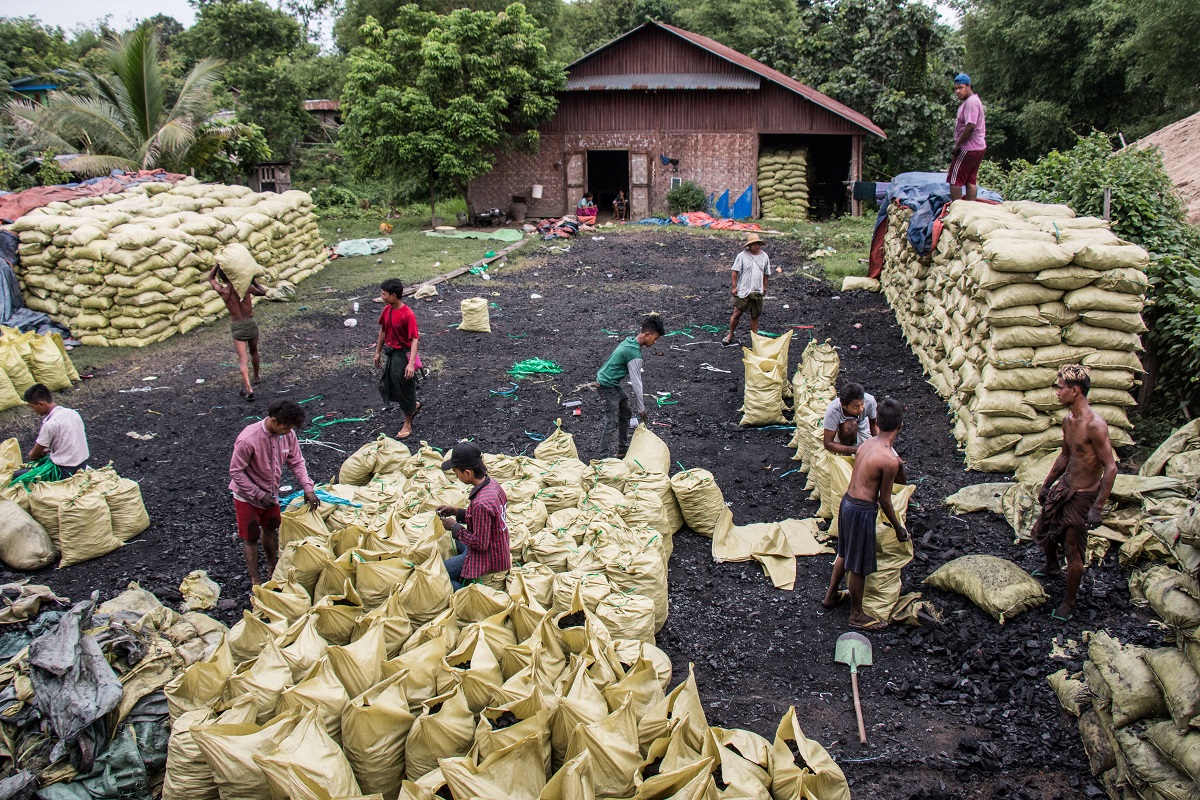
(Photo: Nathan Siegel for Mongabay)
However, he said all of it is used for domestic consumption. That’s why, U Kyaw Zaw explained, the export of charcoal made from wood is illegal, while it is legal to export charcoal made from bamboo and sawdust.
The Forest Department could only provide a 1986 Notification of the Ministry of Agriculture and Forestry to support this stance, and while the regulation imposes considerable red tape to produce and sell charcoal, it doesn’t explicitly forbid exports.
In Bhamo, a trader in a dark green sarong, known locally as a longyi, and a white T-shirt welcomes us into his house. While his young child rides a tricycle around a living room furnished with a few plastic chairs, he explains that money plays a key role in the illicit charcoal trade.
“To go to China from Myanmar, giving money is the major solution,” he said. “Every truck [driver] has to give money to different departments. Money can solve all the problems.” To save a little, this trader hides the charcoal under bags of corn, because the price of the bribe for corn is lower. He would prefer to trade legally and allow the government to collect taxes, and said he would make more money; but instead the bribes are just “pocket money” for some officials, he adds, while sliding an imaginary note into his breast pocket.
Another trader in Bhamo, who asked to remain anonymous, sits with a small group in front of a friend’s house. He angrily tells Mongabay: “I want to burn all the officers, but we have no choice, we have to go so we have to pay.” He explains the process: “First we need to call the [army] officer in Zinlum and ask if we can take our cargo up there. [Then] we need to clear the route with payments here and there. If they tell us not to come, we cannot go.” Once he gets the go-ahead, the high-ranking officials tell the junior officers to accept the payments.
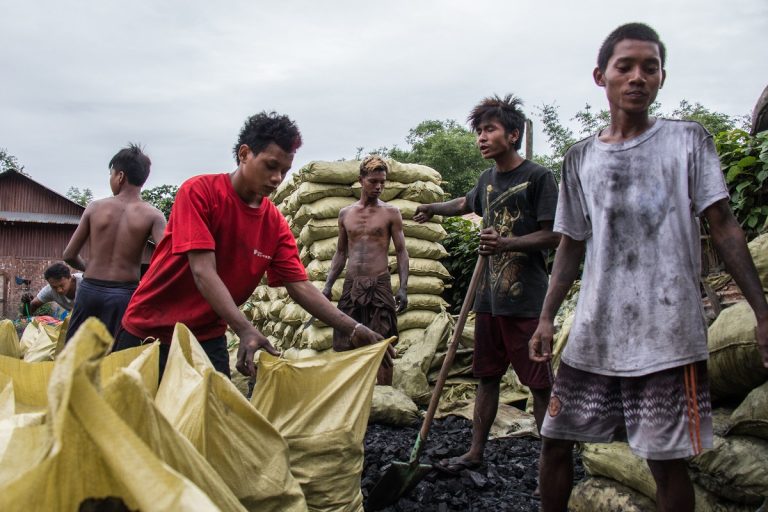
(Photo: Nathan Siegel/Mongabay)
Every ton of charcoal generates about $40 to $85 for corrupt officials, according to estimates based on interviews with four traders. Much of this will go to the high-ranking officials at checkpoints called Zinlum and Chau sa Kakan. Officials posted on the road between Myanmar and Dehong prefecture in China’s Yunnan province pocket an estimated $1 million to $10 million in bribes a year. The exact number is difficult to pinpoint, given the fluid nature of bribes and other under-the-table payments.
Myanmar’s army, which appears to be a regular beneficiary of these bribes, did not respond to repeated requests for comment regarding corruption allegations. The Forest Department acknowledged “there may be involvement of our staff, but if we find out those involvements, we will take action.” Nevertheless, they declined to provide specific details regarding sanctioned officials or even their numbers.
The drive from Bhamo to the border town of Lwegel takes half a day on a bad road along steep hills. Once past the checkpoints on the road out of Myanmar, it’s very easy to enter into China illegally. Trucks take a muddy road that bypasses the official customs post located just a few hundred meters away.
After that, drivers say the trade is conducted in the open. Trucks with Myanmar plates offload their freight in one of the yards whose ground is black from the traffic and where charcoal bags are piled over 10 meters high. This charcoal will feed one of the silicon smelters in Dehong, and possibly beyond.
Feeding China’s Industrial Appetite
Yunnan’s stunning forested hills help make it what Lonely Planet calls “the trendiest destination for China’s exploding domestic tourist industry.” The region has also been China’s doorway to Burma since the 9th century when, in his book Where China Meets India, the historian Thant Myint-U writes, “A visiting troupe of musicians from Burma traveled to the Tang court and performed songs entitled ‘The Victory of the Ram’ and ‘The Peacock King.'”
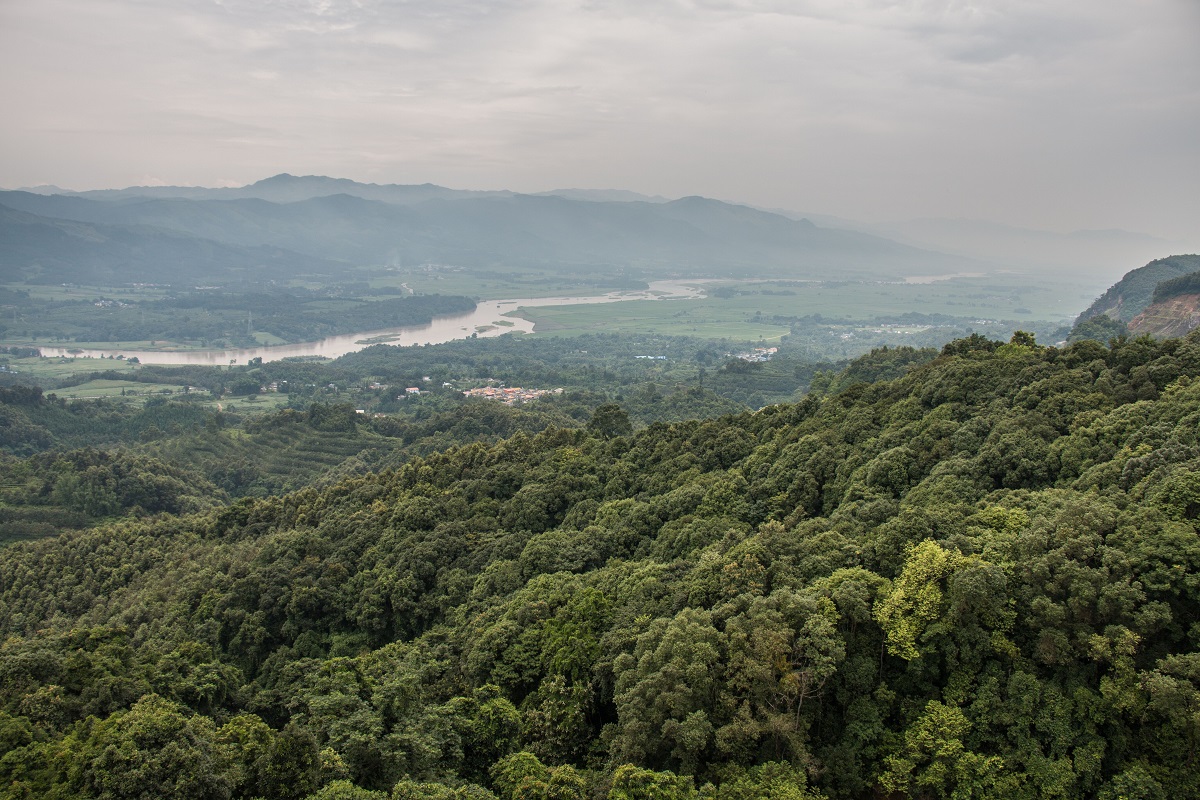
(Photo: Nathan Siegel/Mongabay)
The two countries didn’t just trade cultures. Thant Myint-U describes how “when the border [between China and Myanmar] first opened up in the 1980s, the first sign of the new China was the flood of cheap Chinese goods.”
“The forests of Burma’s north and east were mercilessly chopped down, with hundreds of lorries a day ferrying huge teak and other hardwood logs to waiting Chinese sawmills,” he wrote.
Since then, China has built slick roads to ensure the smooth exchange of Myanmar’s natural resources for phones, motorbikes, and plastic wares.
Myanmar’s charcoal can be used for the production of two types of materials: ferrosilicon and silicon metal. The first is used in the production of stainless steel and other widely used alloys. The second is used for aluminum alloys, as well as the production of semiconductors for electronics, photovoltaic cells for solar panels, and even cosmetics.
Both are produced through similar chemical reactions that take place at an extremely high temperature, requiring cheap electricity that’s supplied by Yunnan’s dams. Carbon, often in the form of charcoal, is thrown into furnaces together with mined silica ore to produce silicon metal. To produce ferrosilicon, scrap iron is added to the mix.
China produces over two-thirds of the world’s ferrosilicon and silicon metal, with around a quarter of it coming from the province of Yunnan, especially from the prefecture of Dehong, which neighbors Myanmar. Although other sources of carbon can be used for the production of silicon, Dehong’s smelters seem to primarily use charcoal.
In 2015, a Chinese non-governmental organization called the Tianjin Binhai Environmental Advisory Service Center investigated the pollution caused by Dehong’s silicon industry. It found that it “has caused a serious damage to forest resources,” and estimated that “119,700 tons of charcoal were consumed in the production of industrial silicon in Dehong prefecture in 2014, which would [mean that] 8,000 hectares”—31 square miles—”of forests were cut down.”
In 2016, the industry consumed nearly twice that amount (216,273 tons of charcoal), according to our estimates based on figures provided by the Dehong Commission of Industry and Information Technology (in the annexes of a report available here).
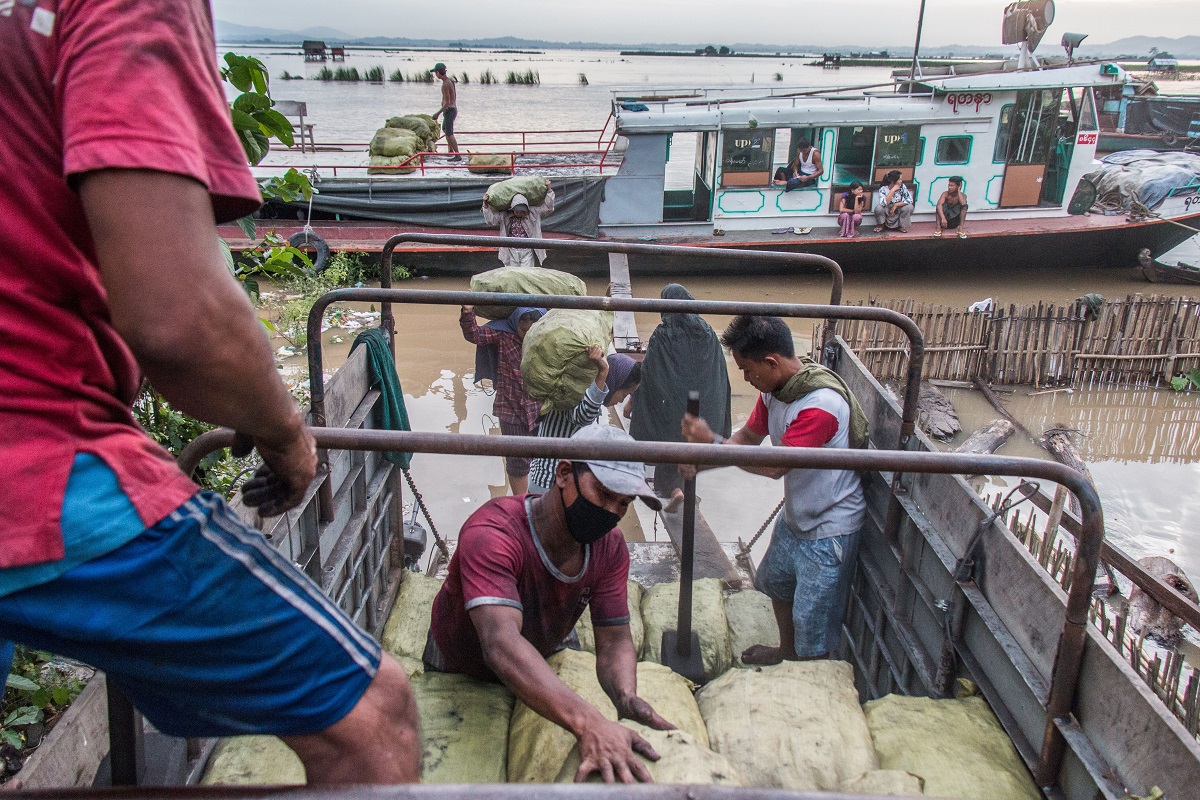
(Photo: Nathan Siegel/Mongabay)
To produce this amount, Dehong’s furnaces need over 14,000 soccer fields of forests to turn to charcoal every year. But the prefecture’s own forests are in no real danger in this regard.
Indeed, a substantial part, maybe all, of this charcoal comes from Myanmar. Ding Jian, the president of a company providing logistics services to smelters, said in an interview with the media outlet Asian Metals that Myanmar’s “charcoal resource supports the production of the high-grade silicon metal in Yunnan.” A forward-looking 2016 report from the Dehong State Bureau of Statistics suggests that, because of the crackdown on charcoal-making in the region, the industry should “make full use of the advantages of overseas [Myanmar’s] resources (electricity, silica mine, and charcoal etc.).”
Myanmar’s Forest Department told Mongabay there had been no charcoal exports in recent years, and provided us with a document that indicates that only 1,169 tons of charcoal had been exported to China between 2004 and 2010. However, over those years, China declared to the United Nation’s Comtrade database that it had imported a total of over 330,000 tons of charcoal from Myanmar. In 2016 alone, the most recent year, China declared that it had imported over 30,000 tons of charcoal from Myanmar. The real figure is likely much higher, given the extent of the smuggling.
Mortgaging the Forests of Future Generations
Myanmar timidly enforces its export ban on wood charcoal. In 2016–17, the Forest Department declared having stopped a total of 91 vehicles transporting charcoal illegally. But only nine of those were in the Sagaing region, where charcoal is produced, and none in Kachin State, through which the charcoal transits to China.
U Kyaw Zaw, of the Forest Department, said that charcoal was not a priority because the illicit trade “is almost non-existent. Because it is not of high value.” He added, “They may smuggle timber, which is of high value and scarce in their country.”
Yet the impact on Myanmar’s forests is real. Kevin Woods, a researcher of Myanmar’s resource politics since the early 2000s, when presented with Mongabay’s findings, wrote in an email that, “while charcoal [has] less value per unit than most commodities smuggled across the border, the cumulative amount paid in bribes per annum is staggering.”
Over the phone, he explained that this production of charcoal “would be like taking the house that you live in, and burning it down [to charcoal] and selling it for firewood.” This jeopardizes the livelihoods of future generations because “you’re dramatically changing the ecology of the area you’re in when you get rid of the forest. The question is why are farmers chopping down their village forest … in order to send charcoal to China? What is the motivation behind that? What my research [mostly in northern Shan State] has shown is that the wider economy is in such shambles for farmers, who are getting further squeezed off their lands.”
Even people involved in the charcoal trade are worried about its impact on the forest. “If I could stop trading, I would like to because the lands in Kachin State are destroyed and the climate changes every year,” said one producer. But with more and more lands given over to large-scale projects, such as dams financed by Chinese companies, it’s likely that they’ll have to keep cutting their trees and burning them.
This story originally appeared at the website of global conservation news service Mongabay.com. Get updates on their stories delivered to your inbox, or follow @Mongabay on Facebook, Instagram, or Twitter.



